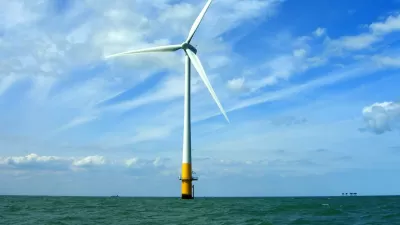Unique geography and high costs have stymied offshore wind energy production in California, but new incentives and innovations could soon make it more accessible.

Writing in the OC Register, Brooke Staggs describes the potential of offshore wind energy in the United States and, specifically, California, where offshore wind production has been held back by geography, among other factors.
“But with wind power now seen as key to helping both California and the U.S. meet their clean energy goals, new state and federal programs are focused on helping us push past those obstacles and become a leader in the offshore wind front,” Staggs writes. “In August, the California Energy Commission set goals of installing offshore wind projects that could generate 2,000 to 5,000 megawatts by 2030 and 25,000 megawatts by 2045. That would be enough electricity to power 3.75 million homes over the next seven years and 25 million homes by mid-century.”
The article describes the challenges of installing offshore wind turbines in the deep waters off the California coast, which require floating installations rather than turbines anchored to the sea floor, making it more expensive. California’s situation is complicated by the vast amounts of coastline controlled by the Department of Defense, which are currently off limits to wind energy projects. But with technology rapidly improving and incentives from the federal government adding a boost, offshore wind energy along the West Coast could soon be a reality. “[T]wo areas off the coast of Humboldt and three areas near Morro Bay, totalling a combined 373,000 acres, have so far been identified as prime floating wind farm locations. If fully developed, the projects could generate 4,500 megawatts of electricity, or enough power for 1.5 million homes.”
FULL STORY: Floating wind turbines off California coast soon could boost power grid

Montreal Mall to Become 6,000 Housing Units
Place Versailles will be transformed into a mixed-use complex over the next 25 years.

Planetizen Federal Action Tracker
A weekly monitor of how Trump’s orders and actions are impacting planners and planning in America.

Four Reasons Urban Planners Can’t Ignore AI
It’s no longer a question of whether AI will shape planning, but how. That how is up to us.

Bend, Deschutes County Move to Restrict Major Homeless Encampment
City and county officials are closing off portions of an area known as Juniper Ridge where many unhoused residents find shelter, hoping to direct people to housing and supportive services.

High Housing Costs Driving Down Transit Ridership in LA
When neighborhoods gentrify and displace lower-income residents, transit ridership suffers, new research shows.

Iowa Legalizes Accessory Dwelling Units
A new law will allow property owners to build ADUs on single-family lots starting on July 1.
Urban Design for Planners 1: Software Tools
This six-course series explores essential urban design concepts using open source software and equips planners with the tools they need to participate fully in the urban design process.
Planning for Universal Design
Learn the tools for implementing Universal Design in planning regulations.
City of Mt Shasta
City of Camden Redevelopment Agency
City of Astoria
Transportation Research & Education Center (TREC) at Portland State University
City of Camden Redevelopment Agency
Municipality of Princeton (NJ)
Regional Transportation Commission of Southern Nevada





























